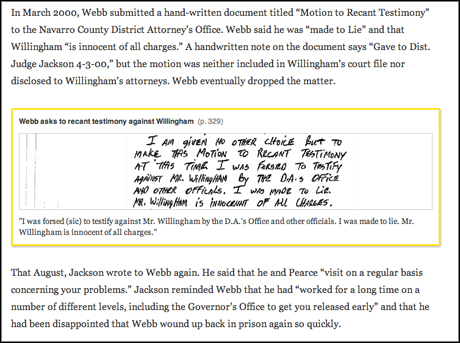
At first glance, a non-profit digital journalism start-up focused solely on covering the American criminal justice system could be a tough sell in terms of gathering an audience.
Still, that's the stall Neil Barsky, a former journalist turned filmmaker and financier, set out when he announced The Marshall Project in late 2013.
But with ex-New York Times executive editor Bill Keller at the helm, and a managing editor team of multiple Pulitzer Prize winners Tim Golden and Gabriel Dance, The Marshall Project could lead the the charge in single-subject journalism in a way that Pierre Omidyar's First Look Media has had to reassess.
"New storytelling methods give a kind of accessibility to certain issues," Dance, who joined The Marshall Project as managing editor for digital from the Guardian in May, told Journalism.co.uk.The criminal justice system is based around human interest stories so much... the emotion of it is really something that people can relate toGabriel Dance, managing editor for digital, The Marshall Project
"The NSA project is a really good example – both technically and legally very complicated and very niche. Not many people previous to those leaks were super concerned about technological security and national security invading their privacy."
Making the topic and detail accessible to a wide audience through a range of interactive and multimedia methods was one of the reasons Dance was hired, based on his work at the Guardian.
"The criminal justice system is based around human interest stories so much, like the article we just co-published with the Washington Post and on our site," he continued. "While it does get complicated in terms of testimony and recanting testimony it ultimately is tied to a human life so people are interested in that. The emotion of it is really something that people can relate to."
The Marshall Project published its first story last week in partnership with the Washington Post: a 5,000 word investigation, called 'The Prosecutor and The Snitch', into the case of Texas man Todd Willingham.
In 1991, Willingham's three daughters died in a fire at the family home. He was convicted of arson and executed in 2004.
"[Willingham] was convicted based on two pillars of testimony," Keller told Journalism.co.uk, "one of them a forensics expert who claimed that the fire was arson... and then there was a jailhouse informant who testified that Willingham had confessed to him in prison that he did in fact set the fire."
The forensic evidence had long ago been discredited as invalid, said Keller, and his organisation's piece focused on "documentary evidence" that the jailhouse informant, Johnny Webb, had "made up the story in exchange for promises from the prosecutor" of a job, money and a reduction in charges.

Screengrab from TheMarshallProject.org showing Johnny Webb's hand-written note, recanting his testimony against Willingham
Initially intended for publication on the website's full launch, the decision to run the story online and in the Post last week came as a pressure group sought to file a complaint against the prosecutor involved in the case.
Despite not including the digital bells and whistles Keller and Dance say will become a mainstay of the finished product, 'The Prosecutor and The Snitch' still saw more than half a million views in two days, said Keller, a number Dance said almost half of which came from mobile.
"Good journalistic writing, combined with what you can do online and with social media to tell the story visually, means we can reach an audience that the drier academic research may not reach," said Keller.
"What's really changing is the way we're going to approach doing these stories as a whole," Dance said, "which is to say, sure, there will still be a primary reporter who's working on it and doing a lot of the interviews etc., but there will also be interactive reporters.
"My data editor Tom Meagher is working closely with all of the reporters as we begin to say what elements of this story can be best told in ways that are perhaps not very conducive to just writing."
Finding points of a story that can be best told in a manner other than text, said Dance, is an approach that would have been taken with the Willingham story had they worked to the original plan.
"The point of the story isn't to have an 800-word sidebar on the duration people spend on death row in Texas," Dance offered as an example, "but those are really interesting elements of this story – that are important to the overall context of it – that we could have jumped in and done a few graphics, even charts and tables.One of the reasons that we're not launching until October is we have a team building a content management systemBill Keller, editor-in-chief, The Marshall Project
"These don't have to be intensive interactives but would really further the storytelling and help us do a better job of storytelling and also appeal to different audiences. So some of the people who could more easily be engaged through visual story telling or charts."
Keller said these elements will be integral to The Marshal Project on its full launch.
"We are very much about finding different ways to tell stories," he said. "One of the reasons that we're not launching until October is we have a team building a content management system [CMS], designing home pages and articles pages and in particular designing a number of features that will be very interactive, very visual and use photography, video, data and so on."
Dance and director of technology Ivar Vong built the current site in three days, said Keller, but the long-term work has been going into researching and constructing a CMS that is specific to the needs of the Marshall Project in all its forms.
By speaking to the founders of new sites like Quartz and FiveThirtyEight, Dance and Vong have come to understand the pros and cons of established content management systems that are available, and what they need to push the area forward with The Marshall Project.
"Having no legacy is really important," he said. "We really decided that we wanted to pursue storytelling and new site techniques that weren't available were we to use [something like] WordPress. And these include things like different tagging methods as well as the ability to link stories together pegged to a news story, as opposed to a tagging system."
Beyond the complex and as-yet-unfinished new tagging system, Dance said the new CMS would be "format agnostic" in how it treated and integrated different forms of media.These are stories where you work very hard to put a human face on them and you don't want them to just be social science and dataBill Keller, The Marshall Project
"We want to be able to use interactive graphics, maps, charts, words, all on the same page, and all in a way that the reader is not taken out of the story, regardless of what format they're consuming it in," he said.
"It's not like I'm coming up with any brand new types of content, but all of our content with the new CMS is going to be treated the same."
Everything The Marshall Project produces will be "custom-made for online presentation", said Keller, despite continued conversations with the Post, the New York Times and NPR around future collaborations.
"These are stories where you work very hard to put a human face on them and you don't want them to just be social science and data," he said, "so the opportunity for photography and video and audio is very strong."
The Marshall Project will be looking to integrate these elements into its social and mobile offerings, Keller said, alongside the work of audience engagement editor Blair Hickman, a recent hire from Pro Publica.
When they are hiring some of the best minds in the industry and applying all the lessons from those that have come before them, it doesn't look like such a tough sell after all.
"A big part of what we're doing is learning from everybody who has done interesting work and then implementing it in the way that we think is the new form of journalism," said Dance.
"That's actually why we decided to build our own CMS. We felt the only way to charge into this new era of storytelling and new era of journalism is with the proper tools."
Free daily newsletter
If you like our news and feature articles, you can sign up to receive our free daily (Mon-Fri) email newsletter (mobile friendly).
Related articles
- Washington Post opinions editor David Shipley on gearing up for the US election
- Dmitry Shishkin, new CEO of Ringier Media International, on leading growth across 80 media brands
- The Forward removed its paywall and generated 37 per cent more revenue
- Five media sustainability lessons from The Economist
- Seasoned reporting: charting changing tastes in the field of food journalism









